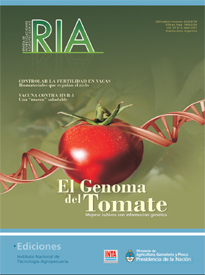Ver ítem
- xmlui.general.dspace_homeCentros Regionales y EEAsCentro Regional Mendoza - San JuanEEA MendozaArtículos científicosxmlui.ArtifactBrowser.ItemViewer.trail
- Inicio
- Centros Regionales y EEAs
- Centro Regional Mendoza - San Juan
- EEA Mendoza
- Artículos científicos
- Ver ítem
Estimación de potencial hídrico en vid por medio de medidas termográficas y espectrales
Resumen
El potencial hídrico foliar (ΨL) es una variable frecuentemente utilizada para medir el estado hídrico de los cultivos. Su medición con cámara de presión es lenta, lo que impide tomar un gran número de muestras. El objetivo del trabajo fue evaluar métodos alternativos para estimar el ΨL mediante sensores remotos. Uno de los métodos utilizados fue el de la reflectancia espectral. Esta técnica requiere de análisis estadísticos para poder estimar las
[ver mas...]
El potencial hídrico foliar (ΨL) es una variable frecuentemente utilizada para medir el estado hídrico de los cultivos. Su medición con cámara de presión es lenta, lo que impide tomar un gran número de muestras. El objetivo del trabajo fue evaluar métodos alternativos para estimar el ΨL mediante sensores remotos. Uno de los métodos utilizados fue el de la reflectancia espectral. Esta técnica requiere de análisis estadísticos para poder estimar las variables de interés. Se probaron dos análisis, el cálculo de índices a partir de los valores del espectro y el análisis de Mínimos Cuadrados Parciales (PLS). El otro método probado fue la termografía que registra las Temperaturas de la Canopia (TC), que se relacionan con su estado hídrico. Los datos termométricos sirvieron para construir dos modelos de regresión que estimaron ΨL. Uno de los modelos fue una regresión simple con TC vs. ΨL; el otro fue una regresión múltiple construida junto con el "índice normalizado de vegetación" (NDVI = ((R900-R680)/( R900-R680) y con el "índice hídrico" (WI = (R900/R970)). El ensayo se llevó a cabo en un viñedo de la variedad Malbec, en Mendoza, Argentina. La reflectancia se midió durante la mañana y el ΨL al mediodía, paralelamente a la toma de imágenes termográficas. Por PLS, usando las reflectancias entre 325 y 1075 nm, se pudo predecir el ΨL. Por regresión se obtuvieron las ecuaciones ΨL = -1,21659 + 0,445078 * TC; R2 =0,19, p = 0,0000 y ΨL = 1,83399 - 0,613766 * NDVI + 0,0447517 * TC -1,45787 * WI, R2 = 0,36, p = 0,0000. Al mapear mediante krigeado los ΨL observados y los estimados por los tres procedimientos, para analizar las similitudes en distribución espacial se observó una apreciable semejanza entre ellos a pesar de los bajos coeficientes de regresión encontrados. Esto es así porque los planos incluyen información espacial ausente en las regresiones. Se halló una mayor semejanza entre el ΨL observado y el estimado por PLS, comparado con los otros métodos.
[Cerrar]
Leaf water potential (ΨL) is a useful variable for the water status assessment of crops. The pressure
chamber is the current method for its measurement, but has the disadvantage of being too slow and
impractical when to asses an important number of plants become necessary, as is required in Precision
Viticulture. The objective of this investigation was to evaluate alternative methods for estimating ΨL, using
remote sensors. One of these methods was
[ver mas...]
Leaf water potential (ΨL) is a useful variable for the water status assessment of crops. The pressure
chamber is the current method for its measurement, but has the disadvantage of being too slow and
impractical when to asses an important number of plants become necessary, as is required in Precision
Viticulture. The objective of this investigation was to evaluate alternative methods for estimating ΨL, using
remote sensors. One of these methods was based on spectral reflectance. This is a non destructive, quick
and efficient method. Nevertheless, this technique requires statistical analysis in order to estimate the needed variables. In this study, two analyses were tested. On one side, we calculated indexes from spectral values, and on the other side, we tested the Partial Least Squares analysis (PLS). The other tested method was based on Thermography Canopy temperature (TC) is known to be related to water status. In this case, images of the canopy of the vineyard were taken, and the temperatures of each point of the assessed area were recorded. Two regression models derived from the thermographic data: one of these models was a simple regression with TC vs. ΨL; and the other was a multiple regression, including temperature, the reflectance indices NDVI (R900-R680/R900+R680) and WI (R900/R970). The assessment took place in a
Malbec vineyard, in Mendoza, Argentina. Reflectance was measured during the morning and ΨL at noon,
just at the same time as the images were taken. By PLS, using reflectances from 325 to 1075 nm, ΨL could be estimated. With simple and multiple regressions the following equations were obtained: ΨL = -1.21659 + 0.445078 * Tº; R2 =0,19 and ΨL = 1,83399 - 0,613766 * NDVI + 0,0447517 * TC -1,45787 * WI, R2 = 0,36, p = 0,0000. When the observed and estimated ΨL obtained by the three procedures were mapped by krigging in order to analyze the likelihood between the spatial distributions, a high level of similarity was found, dispite the low regression coefficients. Aparently, the maps include spacial information that is absent in the regressions. Higher likelihood was found between the measured ΨL and the estimated by PLS, when compared to the other methods.
[Cerrar]

Fuente
RIA 37 (1) : 46-53 (abril 2011)
Fecha
2011-04
Editorial
Gerencia de Comunicación e Imagen Institucional, DNA SICC, INTA
ISSN
0325-8718
1669-2314
1669-2314
Formato
pdf
Tipo de documento
artículo
Palabras Claves
Derechos de acceso
Abierto
 Excepto donde se diga explicitamente, este item se publica bajo la siguiente descripción: Creative Commons Attribution-NonCommercial-ShareAlike 2.5 Unported (CC BY-NC-SA 2.5)
Excepto donde se diga explicitamente, este item se publica bajo la siguiente descripción: Creative Commons Attribution-NonCommercial-ShareAlike 2.5 Unported (CC BY-NC-SA 2.5)


